10 Inexpensive Automotive USB Adapters Tested -- Are They Any Good?
Fourth Batch: The Blind Bag
Now that I have exhausted my inventory of at least seemingly similar adapters, I have three left with completely different designs, completely different features, and completely different specifications from each other.
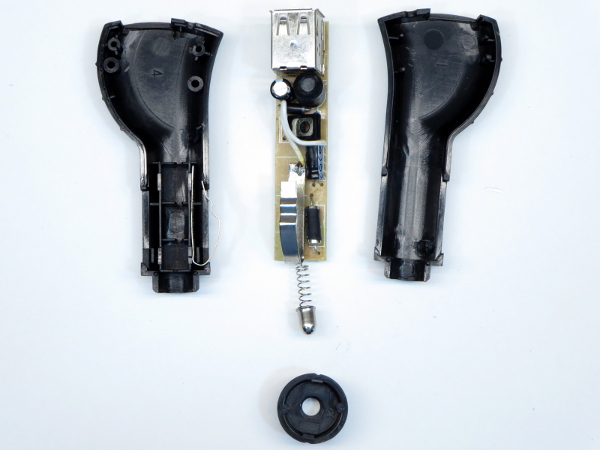
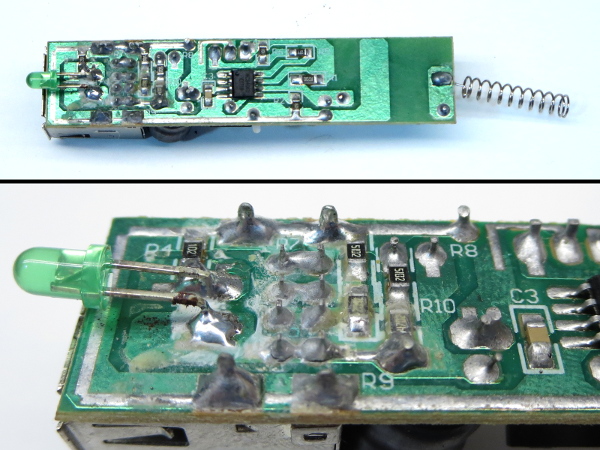
The first contender is a Sakar-branded unit that comes apart by first twist-unlocking the piece holding the positive contact, followed by heavy prying along the perimeter to break the glue/solvent bonding near the USB ports and popping the stakes. I was initially a little surprised by the twist-off tip and expected to see a fuse hidden behind it, but it turned out to be nothing more than the tip retainer and fastener for the two halves. The top side of its single-sided board hosts a fuse with through-hole leads, the usual assortment of through-hole components, an SOT-32 B772 transistor, and a pair of stacked USB ports. Finding a discrete transistor here is strange for an adapter only rated for 1 A when nearly all integrated controllers can drive a 1 A load directly. On the back side of the board, we find the MC3406 regulator chip, one of the most deeply flux-encrusted solder jobs I have seen for the through-hole USB sockets, and a green power indicator LED. Soldering on the rest of the board looks normal.
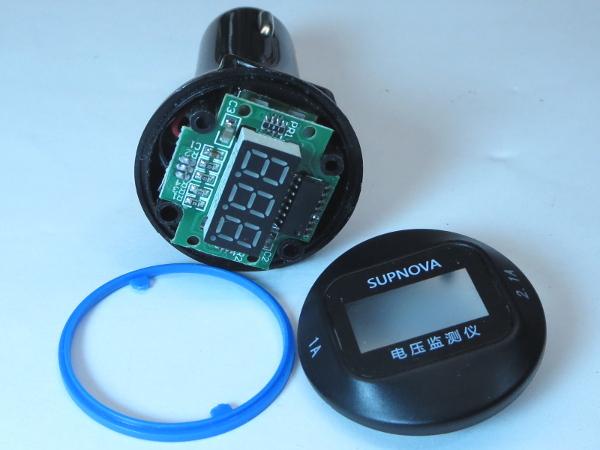

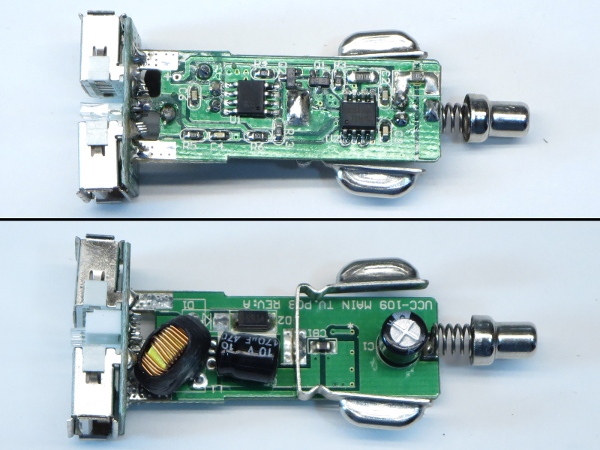
The Supnova adapter comes apart the same way as the blue adapter. Its face is staked onto the end, requiring only moderate prying to pop off, revealing its built-in voltmeter board. While having a built-in system voltage meter sounds neat, the readout only has 0.1 V resolution and was consistently 0.3 V lower than my multimeters. Behind the meter PCB, you find three wires providing it power and the measurement voltage, along with a plastic sticker saying “YOUR LOGO HERE.” That’s an odd location for promotional material. If you haven’t guessed what this sticker is there for, it is there to provide some electrical isolation between the back of the PCB and the USB connector’s metal shell. Someone goofed up in the design process by omitting mechanical restraint to keep the meter board and USB shells from shorting out against each other, and the manufacturer worked around the issue by stuffing whatever it had on-hand that might pass as insulation in-between.
This is yet another unit sporting a sub-PCB for the USB ports and a white LED in-between for power indication. On the top side of this dual-layer PCB, we find the usual input and output capacitors, an inductor, and a diode, while the bottom hosts a zero-ohm resistor where a fuse should have been, two SO-8 packages, a pair of unexpected SOT-23 components, and a bunch of passives. Seeing how the leads (except pin number four on the left chip) are all connected together on their respective side, this is obviously a power transistor of some sort and the SOT-23 devices must be its driver. This would explain how a device using a regulator only capable of 1.5 A might be able to meet its 2.1 A output rating.
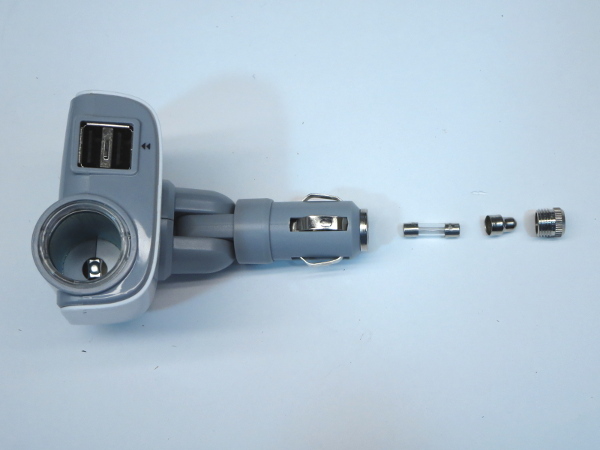
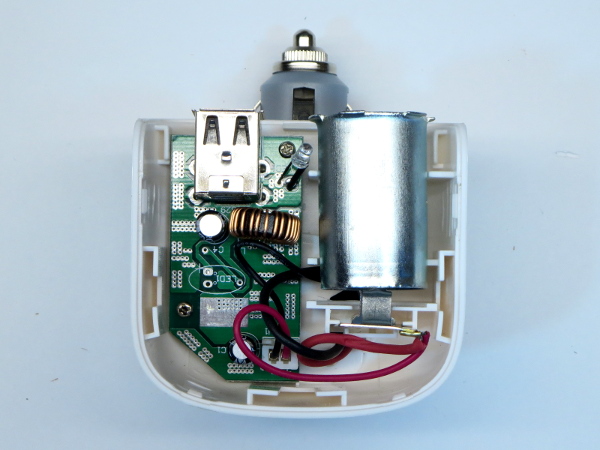

Lastly, weighing in at three to four times the size of most other adapters, we have the huge Wagan unit with its articulated fuse-holding plug and pass-through 12 V power outlet. It is the only unit featuring a proper tool-free and user-replaceable fuse, where most contenders have no fuse whatsoever. To access the fuse, simply unscrew the tip’s retaining cap from the plug. Getting to the electronics requires popping three plastic clips on the top and one more on the face where the outlets are. About half of the space under the hood is consumed by the 12 V pass-through outlet and wiring, while the other half is taken by what looks like a typical component complement from the top. On the bottom, we also find passive components, a rectifier, a switching regulator, and a large amount of via-stitching throughout the board. Power indication is provided by a blue LED illuminating the transparent ring surrounding the pass-through 12 V outlet. If there is one thing to really like about this board layout, it would be how well it uses most of its surface on both sides to spread heat around.
I tried to find a datasheet for Wagan’s mystery chip, but came up empty. All of the components I looked at in an attempt to find a plausible match were clear misses for at least one of the three basics: VIN on pin #8, GND on pin #3, and feedback on pin #4. Since the whole thermal pad area is cribbed with thermal vias connecting to the switching node’s copper pours on both sides, there won’t be any traces sneaking their way across the chip under there. Having such a large area switching node with no ground plane must be horrible for EMI.
| Header Cell - Column 0 | Sakar | Supnova | Wagan |
|---|---|---|---|
| Adapter Rating | 1000 mA | 2100 mA | 3100 mA |
| Regulator | MC34063 | MC34063 | DY14MA33 |
| Regulator Ratings | 40 V, 1.5 A, 100 kHz max, 85% eff. typ. | 40 V, 1.5 A, 100 kHz max, 85% eff. typ. | (No info) |
| Input capacitor | YC 35 V, 47 µF | HongKai 35 V, 100 µF | Jakec 50 V, 47 µF |
| Output capacitor | YC 10 V, 470 µF | Micon 10 V, 470 µF | Jakec 16 V, 220 µF |
| Rectifier Diode | SR560(5 A, 60 V Schottky) | SS34(3 A, 40 V Schottky) | SS56(5 A, 60 V Schottky) |
| External Switch | B772(3 A, 60 V PNP) | TF437F(No info) | - |
| Input protection | Soldered axial fuse | 0 Ω resistor | 8 A user-replaceable fuse |
All three of these adapters use discrete rectifiers and, surprisingly enough, the Sakar unit uses a 5 A diode despite its meager 1 A output rating. Will this give it an efficiency edge against the other two contenders? We’ll see soon enough. But if that really is a PNP transistor in there acting as its main switch, good efficiency sounds unlikely with almost 1 V of saturation voltage. We also see many new capacitor brands that I don't remember seeing before. I would like to say that all three of these look like they should be able to handle the occasional 40 V spike, but with no datasheet for Wagan’s custom-marked chip, I can't even venture a guess.
Get Tom's Hardware's best news and in-depth reviews, straight to your inbox.
Can you predict which unit will perform best relative to its ratings? I’d guess Wagan's sample, since it comes closest to resembling a modern implementation, followed by Supnova for possibly using an external FET switch, with Sakar coming in last due to its seemingly unnecessary external transistor (and not a particularly good one at that).

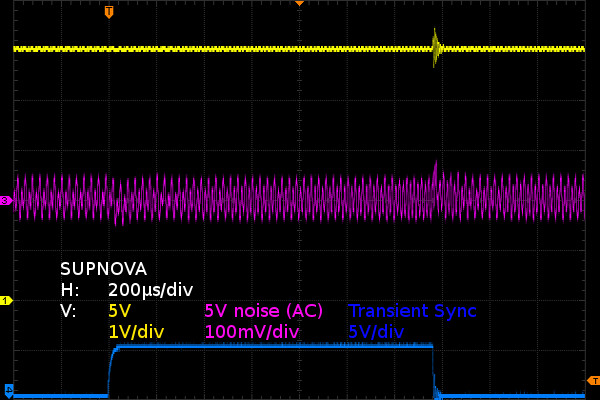
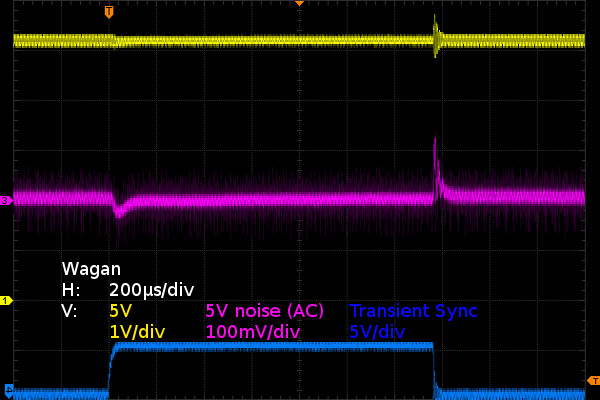
There are no apparent input voltage regulation issues and no shocking revelations in the waveforms. The MC34063’s low switching frequency translates into high ripple voltage, especially for Sakar’s smaller spool inductor. Supnova's toroidal inductor improves the results by cutting noise in half, despite its slightly lower switching frequency. Neither of them come anywhere close to Wagan’s more modern design and its anonymous chip operating at a much higher frequency.
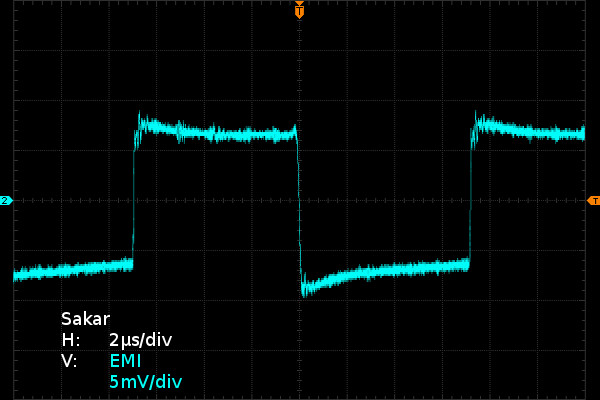
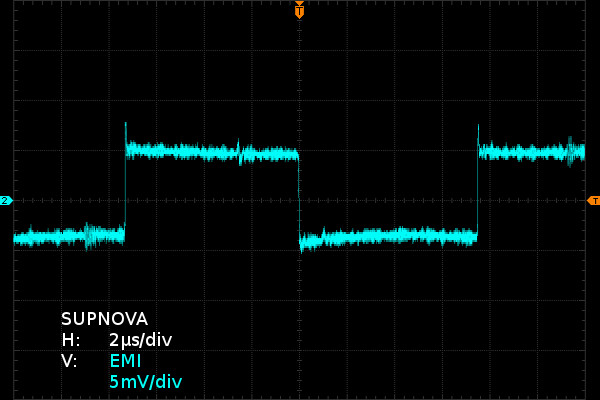
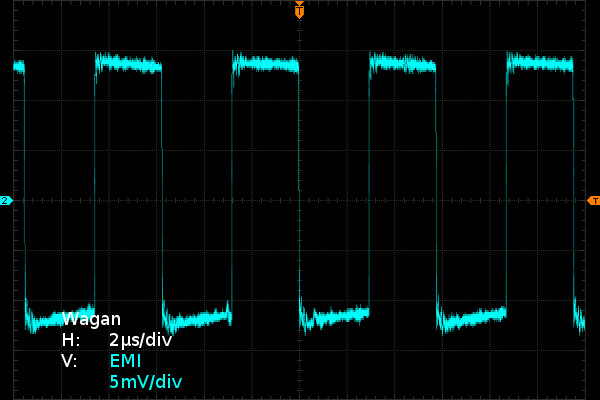
To test my earlier EMI performance theory, I performed a crude EMI test by unplugging all unnecessary wiring and unused probes, using the hook attachment on my one remaining probe as an antenna, and trying different orientations and locations all around the adapters’ housing to find the worst signal I could. While this is not a calibrated test, it does give a general idea of how much better or worse devices fare relative to each other. I did test most other adapters when I came up with this idea and they all fell somewhere in-between the Supnova and Sakar, which does not surprise me. The Sakar has a long PCB that extends far outside of the 12 V outlet, leaving a large part of it unshielded by the grounded barrel. The Supnova's stubbier body leaves less exposed area and its USB connector sub-PCB with its connectors’ shields cap off the end. This surrounds most of the circuitry with some degree of shielding. The Wagan’s circuitry, on the other hand, is fully exposed from nearly every angle, and the third of its PCB accounting for the switching node acts as a small planar antenna, belching out plenty of signal for my probe to pick up (about twice as much as the next-worst result).
In short, using large double-sided copper pours connected to the switching node as a heat sink for your switching regulator is a bad idea for EMI. Follow the switching regulator manufacturers’ recommendations and use a ground plane instead.
| Header Cell - Column 0 | Test Current | Sakar | Supnova | Wagan |
|---|---|---|---|---|
| Output Voltage | 500 mA | 5.15 V | 5.12 V | 5.27 V |
| 1000mA | 5.15 V | 5.11 V | 5.25 V | |
| 2100 mA | - | 5.05 V | 5.22 V | |
| 3100 mA | - | - | 5.19 V | |
| Input Power | 500 mA | 3.318 W(276 mA @ 12.02 V) | 3.366 W(280 mA @ 12.02 V) | 2.995 W(249 mA @ 12.03 V) |
| 1000 mA | 6.805 W(569 mA @ 11.96 V) | 6.254 W(522 mA @ 11.98 V) | 5.942 W(496 mA @ 11.98 V) | |
| 2100 mA | - | 13.722 W(1157 mA @ 11.86 V) | 12.631 W(1065 mA @ 11.86 V) | |
| 3100 mA | - | - | 19.185 W(1630 mA @ 11.77 V) | |
| Efficiency | 500 mA | 78% | 77% | 88% |
| 1000 mA | 76% | 82% | 88% | |
| 2100 mA | - | 77% | 87% | |
| 3100 mA | - | - | 84% | |
| Noise (RMS) | 500 mA | 19 mV | 19mV | 22 mV |
| 1000 mA | 47 mV | 24 mV | 30 mV | |
| 2100 mA | - | 12 mV | 49 mV | |
| 3100 mA | - | - | 65 mV | |
| Cold Current Limit | - | 1650 mA | 3600 mA | 3400 mA |
| Hot Current Limit | - | 1550 mA | 3000 mA | 320 0mA |
| 10-Second Short-Circuit | - | Pass(1.55 A continuous) | Pass( 3 A continuous) | Pass(3.2 A continuous) |
Shockingly enough, all three units meet their respective output ratings. Sakar’s efficiency does not end up as low as I thought it would, though it's not great either, splitting the distance between the first trio’s 66% average and most other units in the round-up at 80-90%. Then again, between the $3 purple adapter and the $4 Sakar unit from the same electronics shop, the Sakar is still a massive improvement in value and efficiency. Having a regulator chip rated 10 V higher doesn’t hurt automotive survival odds, either. The Supnova adapter’s efficiency takes a small hit compared to Sakar’s at low power from the overhead of having drive circuitry between its switching regulator and external switch, but makes up for it by beating Sakar by 6% at 1 A output efficiency. As I predicted, the Wagan unit pulls ahead of the other two with efficiency staying above 84% in all cases.
Why can’t Wagan’s unit break 90% efficiency? Because it uses a rectifier diode. Even the best 60 V silicon diodes still introduce a 0.5 V voltage drop at forward currents as low as 1 A, and when the output voltage is only 5 V, that 0.5 V becomes a 9% (0.5/(5+0.5)) baseline efficiency handicap. With Wagan’s efficiency starting at 88%, we can deduce that below 2.1 A, the bulk of Wagan’s losses are from its diode. While there are silicon diodes with lower forward voltage drops, those are also diodes with lower reverse voltage ratings. Since the switching node of a buck regulator gets connected to input voltage when the buck transistor gets turned on, the diode’s reverse blocking voltage has to meet the worst-case input voltage specifications, which is why you see 40-60 V diodes used here instead of the 20-30 V ones you may see on the low voltage side of computer power supply reviews. On even lower voltage supply rails, synchronous rectification becomes effectively mandatory to achieve any sort of efficiency.
Current page: Fourth Batch: The Blind Bag
Prev Page Third Batch: Anodized Aluminum Club Next Page Anything Worth Owning?